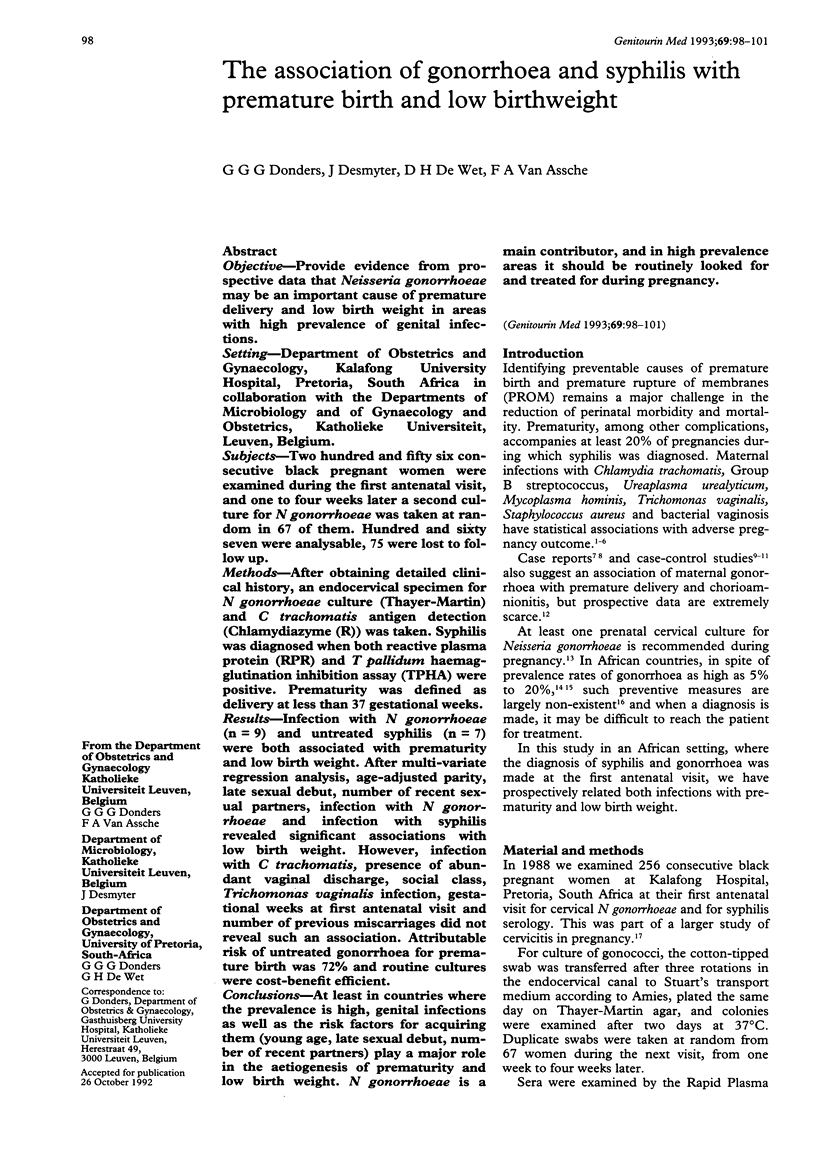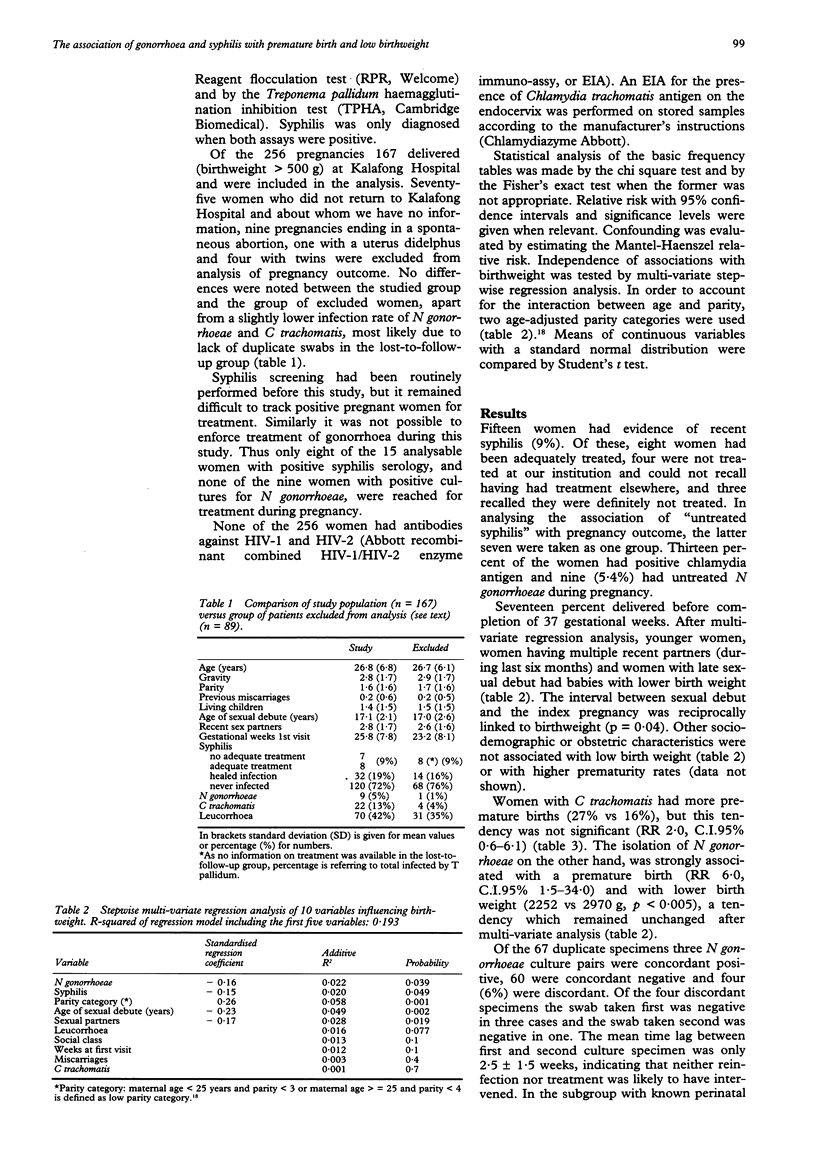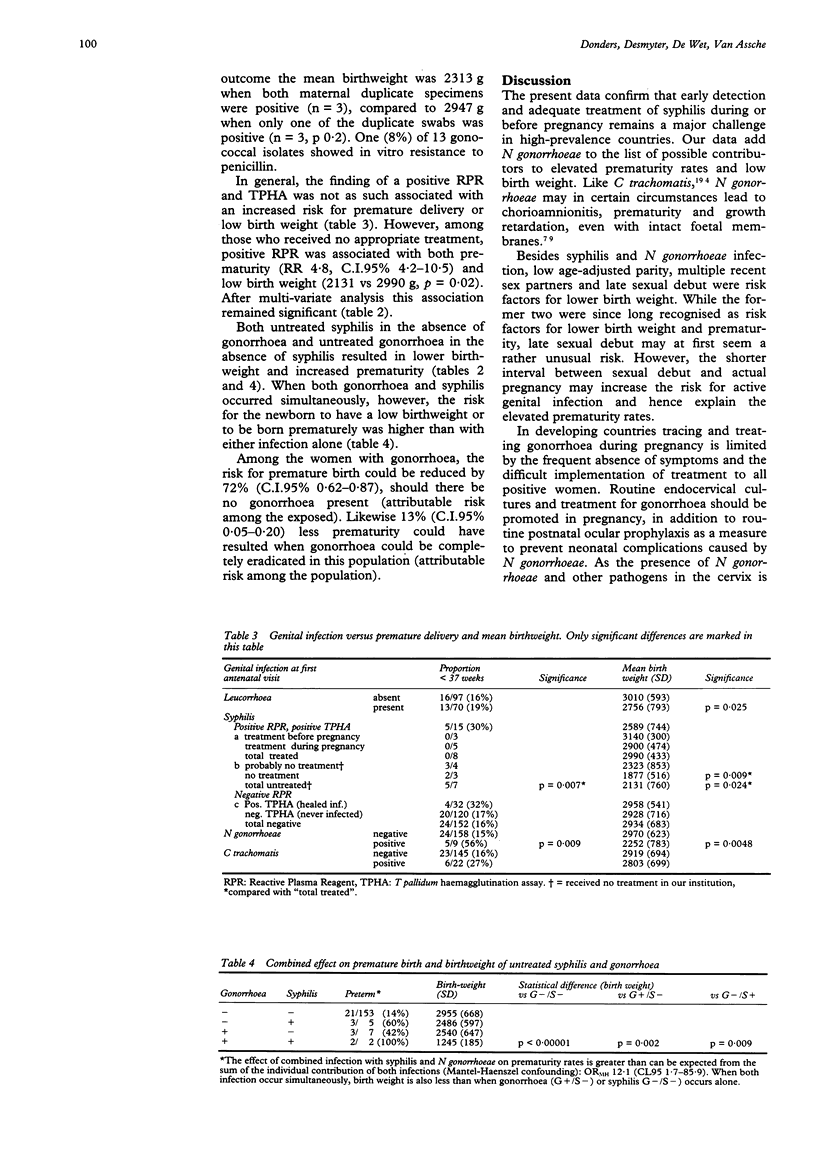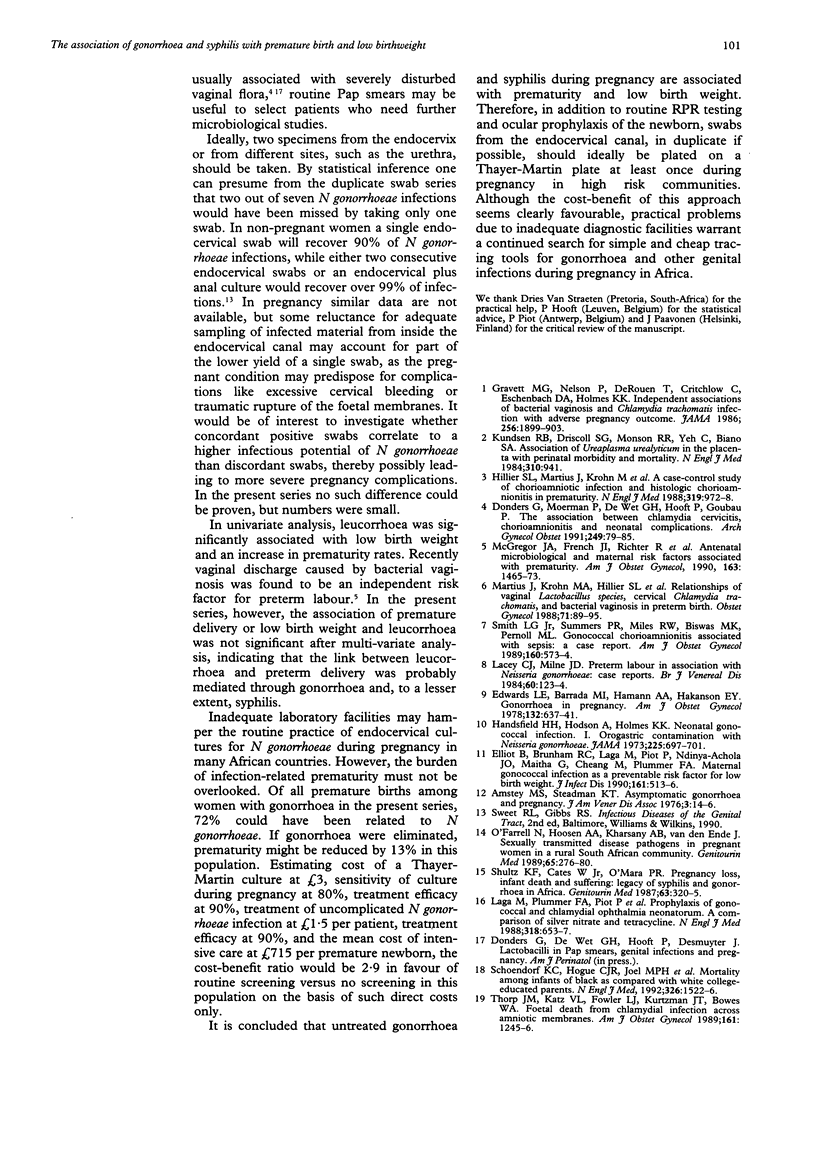Abstract
OBJECTIVE--Provide evidence from prospective data that Neisseria gonorrhoeae may be an important cause of premature delivery and low birth weight in areas with high prevalence of genital infections. SETTING--Department of Obstetrics and Gynaecology, Kalafong University Hospital, Pretoria, South Africa in collaboration with the Departments of Microbiology and of Gynaecology and Obstetrics, Katholieke Universiteit, Leuven, Belgium. SUBJECTS--Two hundred and fifty six consecutive black pregnant women were examined during the first antenatal visit, and one to four weeks later a second culture for N gonorrhoeae was taken at random in 67 of them. Hundred and sixty seven were analysable, 75 were lost to follow up. METHODS--After obtaining detailed clinical history, an endocervical specimen for N gonorrhoeae culture (Thayer-Martin) and C trachomatis antigen detection (Chlamydiazyme (R)) was taken. Syphilis was diagnosed when both reactive plasma protein (RPR) and T pallidum haemagglutination inhibition assay (TPHA) were positive. Prematurity was defined as delivery at less than 37 gestational weeks. RESULTS--Infection with N gonorrhoeae (n = 9) and untreated syphilis (n = 7) were both associated with prematurity and low birth weight. After multi-variate regression analysis, age-adjusted parity, late sexual debut, number of recent sexual partners, infection with N gonorrhoeae and infection with syphilis revealed significant associations with low birth weight. However, infection with C trachomatis, presence of abundant vaginal discharge, social class, Trichomonas vaginalis infection, gestational weeks at first antenatal visit and number of previous miscarriages did not reveal such an association. Attributable risk of untreated gonorrhoea for premature birth was 72% and routine cultures were cost-benefit efficient. CONCLUSIONS--At least in countries where the prevalence is high, genital infections as well as the risk factors for acquiring them (young age, late sexual debut, number of recent partners) play a major role in the aetiogenesis of prematurity and low birth weight. N. gonorrhoeae is a main contributor, and in high prevalence areas it should be routinely looked for and treated for during pregnancy.
Full text
PDF



Selected References
These references are in PubMed. This may not be the complete list of references from this article.
- Amstey M. S., Steadman K. T. Asymptomatic gonorrhea and pregnancy. J Am Vener Dis Assoc. 1976 Sep;3(1):14–16. [PubMed] [Google Scholar]
- Donders G. G., Moerman P., De Wet G. H., Hooft P., Goubau P. The association between Chlamydia cervicitis, chorioamnionitis and neonatal complications. Arch Gynecol Obstet. 1991;249(2):79–85. doi: 10.1007/BF02390366. [DOI] [PubMed] [Google Scholar]
- Edwards L. E., Barrada M. I., Hamann A. A., Hakanson E. Y. Gonorrhea in pregnancy. Am J Obstet Gynecol. 1978 Nov 15;132(6):637–641. doi: 10.1016/0002-9378(78)90856-6. [DOI] [PubMed] [Google Scholar]
- Gravett M. G., Nelson H. P., DeRouen T., Critchlow C., Eschenbach D. A., Holmes K. K. Independent associations of bacterial vaginosis and Chlamydia trachomatis infection with adverse pregnancy outcome. JAMA. 1986 Oct 10;256(14):1899–1903. [PubMed] [Google Scholar]
- Handsfield H. H., Hodson W. A., Holmes K. K. Neonatal gonococcal infection. I. Orogastric contamination with Neisseria gonorrhoea. JAMA. 1973 Aug 13;225(7):697–701. doi: 10.1001/jama.225.7.697. [DOI] [PubMed] [Google Scholar]
- Hillier S. L., Martius J., Krohn M., Kiviat N., Holmes K. K., Eschenbach D. A. A case-control study of chorioamnionic infection and histologic chorioamnionitis in prematurity. N Engl J Med. 1988 Oct 13;319(15):972–978. doi: 10.1056/NEJM198810133191503. [DOI] [PubMed] [Google Scholar]
- Lacey C. J., Milne J. D. Preterm labour in association with Neisseria gonorrhoeae: case reports. Br J Vener Dis. 1984 Apr;60(2):123–124. doi: 10.1136/sti.60.2.123. [DOI] [PMC free article] [PubMed] [Google Scholar]
- Laga M., Plummer F. A., Piot P., Datta P., Namaara W., Ndinya-Achola J. O., Nzanze H., Maitha G., Ronald A. R., Pamba H. O. Prophylaxis of gonococcal and chlamydial ophthalmia neonatorum. A comparison of silver nitrate and tetracycline. N Engl J Med. 1988 Mar 17;318(11):653–657. doi: 10.1056/NEJM198803173181101. [DOI] [PubMed] [Google Scholar]
- Martius J., Krohn M. A., Hillier S. L., Stamm W. E., Holmes K. K., Eschenbach D. A. Relationships of vaginal Lactobacillus species, cervical Chlamydia trachomatis, and bacterial vaginosis to preterm birth. Obstet Gynecol. 1988 Jan;71(1):89–95. [PubMed] [Google Scholar]
- McGregor J. A., French J. I., Richter R., Franco-Buff A., Johnson A., Hillier S., Judson F. N., Todd J. K. Antenatal microbiologic and maternal risk factors associated with prematurity. Am J Obstet Gynecol. 1990 Nov;163(5 Pt 1):1465–1473. doi: 10.1016/0002-9378(90)90607-9. [DOI] [PubMed] [Google Scholar]
- O'Farrell N., Hoosen A. A., Kharsany A. B., van den Ende J. Sexually transmitted pathogens in pregnant women in a rural South African community. Genitourin Med. 1989 Aug;65(4):276–280. doi: 10.1136/sti.65.4.276. [DOI] [PMC free article] [PubMed] [Google Scholar]
- Schoendorf K. C., Hogue C. J., Kleinman J. C., Rowley D. Mortality among infants of black as compared with white college-educated parents. N Engl J Med. 1992 Jun 4;326(23):1522–1526. doi: 10.1056/NEJM199206043262303. [DOI] [PubMed] [Google Scholar]
- Schulz K. F., Cates W., Jr, O'Mara P. R. Pregnancy loss, infant death, and suffering: legacy of syphilis and gonorrhoea in Africa. Genitourin Med. 1987 Oct;63(5):320–325. doi: 10.1136/sti.63.5.320. [DOI] [PMC free article] [PubMed] [Google Scholar]
- Smith L. G., Jr, Summers P. R., Miles R. W., Biswas M. K., Pernoll M. L. Gonococcal chorioamnionitis associated with sepsis: a case report. Am J Obstet Gynecol. 1989 Mar;160(3):573–574. doi: 10.1016/s0002-9378(89)80030-4. [DOI] [PubMed] [Google Scholar]
- Thorp J. M., Jr, Katz V. L., Fowler L. J., Kurtzman J. T., Bowes W. A., Jr Fetal death from chlamydial infection across intact amniotic membranes. Am J Obstet Gynecol. 1989 Nov;161(5):1245–1246. doi: 10.1016/0002-9378(89)90675-3. [DOI] [PubMed] [Google Scholar]


